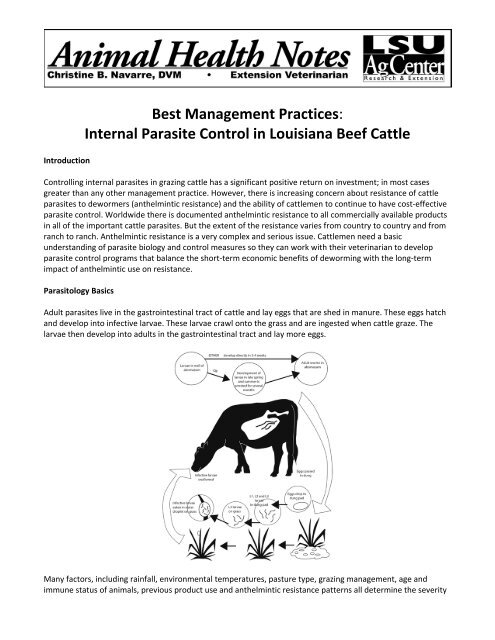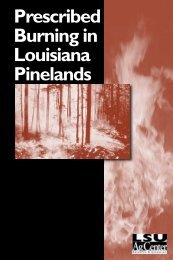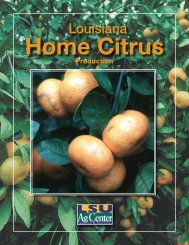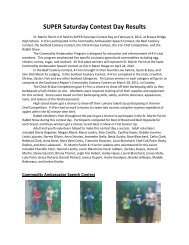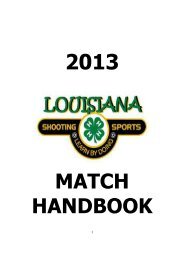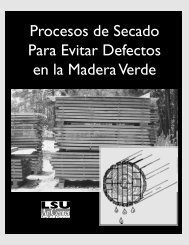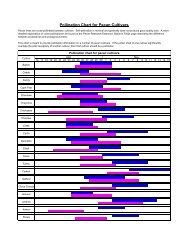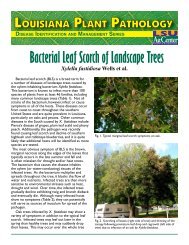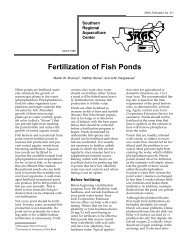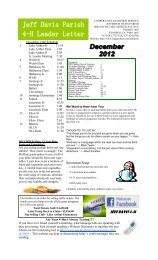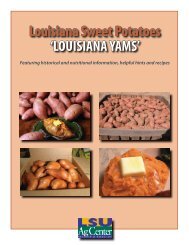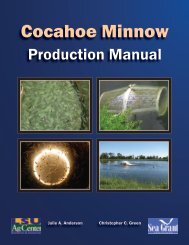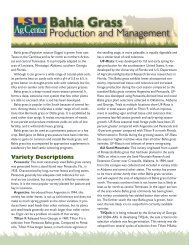Best Management Practices Parasite Control in Beef Cattle
Best Management Practices Parasite Control in Beef Cattle
Best Management Practices Parasite Control in Beef Cattle
Create successful ePaper yourself
Turn your PDF publications into a flip-book with our unique Google optimized e-Paper software.
Introduction<br />
<strong>Best</strong> <strong>Management</strong> <strong>Practices</strong>:<br />
Internal <strong>Parasite</strong> <strong>Control</strong> <strong>in</strong> Louisiana <strong>Beef</strong> <strong>Cattle</strong><br />
<strong>Control</strong>l<strong>in</strong>g <strong>in</strong>ternal parasites <strong>in</strong> graz<strong>in</strong>g cattle has a significant positive return on <strong>in</strong>vestment; <strong>in</strong> most cases<br />
greater than any other management practice. However, there is <strong>in</strong>creas<strong>in</strong>g concern about resistance of cattle<br />
parasites to dewormers (anthelm<strong>in</strong>tic resistance) and the ability of cattlemen to cont<strong>in</strong>ue to have cost‐effective<br />
parasite control. Worldwide there is documented anthelm<strong>in</strong>tic resistance to all commercially available products<br />
<strong>in</strong> all of the important cattle parasites. But the extent of the resistance varies from country to country and from<br />
ranch to ranch. Anthelm<strong>in</strong>tic resistance is a very complex and serious issue. <strong>Cattle</strong>men need a basic<br />
understand<strong>in</strong>g of parasite biology and control measures so they can work with their veter<strong>in</strong>arian to develop<br />
parasite control programs that balance the short‐term economic benefits of deworm<strong>in</strong>g with the long‐term<br />
impact of anthelm<strong>in</strong>tic use on resistance.<br />
Parasitology Basics<br />
Adult parasites live <strong>in</strong> the gastro<strong>in</strong>test<strong>in</strong>al tract of cattle and lay eggs that are shed <strong>in</strong> manure. These eggs hatch<br />
and develop <strong>in</strong>to <strong>in</strong>fective larvae. These larvae crawl onto the grass and are <strong>in</strong>gested when cattle graze. The<br />
larvae then develop <strong>in</strong>to adults <strong>in</strong> the gastro<strong>in</strong>test<strong>in</strong>al tract and lay more eggs.<br />
Many factors, <strong>in</strong>clud<strong>in</strong>g ra<strong>in</strong>fall, environmental temperatures, pasture type, graz<strong>in</strong>g management, age and<br />
immune status of animals, previous product use and anthelm<strong>in</strong>tic resistance patterns all determ<strong>in</strong>e the severity
of parasite problems on an <strong>in</strong>dividual ranch <strong>in</strong> a given year. A unique parasite control program must be<br />
developed for each. The parasite load <strong>in</strong> the animal and on the pasture must both be considered.<br />
Ostertagia ostertagi is an important cattle parasite <strong>in</strong> Louisiana. It can impact both young and mature animals.<br />
Ostertagia likes cool weather, and <strong>in</strong>fective larvae do not survive well <strong>in</strong> the heat of Louisiana summers.<br />
Cooperia sp. and Haemonchus placei are common parasites of calves. They are warm‐season parasites, so large<br />
numbers build up <strong>in</strong> summer months. <strong>Cattle</strong> usually develop immunity to these parasites by the time they are<br />
yearl<strong>in</strong>gs, but adult cattle will cont<strong>in</strong>ue to have low numbers that will contam<strong>in</strong>ate pastures for calves.<br />
Anthelm<strong>in</strong>tic Resistance<br />
Anthelm<strong>in</strong>tic resistance is an <strong>in</strong>evitable consequence of the use of anthelm<strong>in</strong>tics over time. Resistant parasites<br />
have genes that protect them from the effects of the anthelm<strong>in</strong>tic. The parasites may be resistant to one or<br />
multiple products at the same time. Ranches can also acquire anthelm<strong>in</strong>tic‐resistant parasites with herd<br />
additions.<br />
Anthelm<strong>in</strong>tic resistance is usually suspected when a deworm<strong>in</strong>g fails to give the expected production responses.<br />
But poor performance or cl<strong>in</strong>ical signs of parasitism that don’t improve follow<strong>in</strong>g deworm<strong>in</strong>g should not<br />
immediately be <strong>in</strong>terpreted as a failure of the product. Other factors to check <strong>in</strong>clude:<br />
Proper product storage<br />
Proper product adm<strong>in</strong>istration<br />
Dose<br />
Route<br />
Diagnostic test<strong>in</strong>g is required to determ<strong>in</strong>e the existence and extent of parasite problems and anthelm<strong>in</strong>tic<br />
resistance on each ranch. Quantitative fecal egg counts are essential <strong>in</strong> determ<strong>in</strong><strong>in</strong>g the magnitude of parasite<br />
problems, and the fecal egg count reduction test (FECRT) can be used to estimate anthelm<strong>in</strong>tic resistance.<br />
<strong>Parasite</strong> <strong>Control</strong>: A Balanc<strong>in</strong>g Act<br />
One of the key concepts <strong>in</strong> slow<strong>in</strong>g down the development of resistance is the ma<strong>in</strong>tenance of refugia. <strong>Parasite</strong>s<br />
<strong>in</strong> refugia do not have genes for anthelm<strong>in</strong>tic resistance – they are still susceptible to anthelm<strong>in</strong>tics. The more<br />
refugia <strong>in</strong> a population, the more the resistance genes <strong>in</strong> a population are diluted and the more effective<br />
anthelm<strong>in</strong>tics will be.<br />
<strong>Parasite</strong>s <strong>in</strong> refugia can be on pasture or <strong>in</strong> animals. When an entire group of cattle is dewormed, we elim<strong>in</strong>ate<br />
refugia <strong>in</strong> the animals. The only parasites that survive the deworm<strong>in</strong>g are the few that are resistant. These<br />
resistant parasites then mate and multiply and soon take over. Eventually, there is failure of the dewormer to<br />
work as expected.<br />
The overall level of <strong>in</strong>fective larval contam<strong>in</strong>ation of pasture is <strong>in</strong>fluenced by pasture management practices and<br />
environmental pressures. These <strong>in</strong>fluences will impact larvae from both resistant parasites and refugia.
Examples of differ<strong>in</strong>g levels of pasture contam<strong>in</strong>ation:<br />
<br />
<br />
<br />
Contam<strong>in</strong>ated pastures<br />
o Permanent pastures used cont<strong>in</strong>uously for graz<strong>in</strong>g<br />
o Overseeded pastures that have recently been grazed<br />
Clean pastures<br />
o Environmental temperature impacts on pastures left fallow for a season<br />
• Ostertagia larvae don’t survive well <strong>in</strong> summer<br />
• Cooperia and Haemonchus don’t survive well <strong>in</strong> w<strong>in</strong>ter<br />
o Pastures grazed by other livestock species<br />
o Stocker pastures grazed by cows (cleaner)<br />
Cleanest pastures<br />
o Non‐permanent pastures<br />
• Tilled and planted<br />
• Used for harvest<strong>in</strong>g hay<br />
The quickest way to get widespread anthelm<strong>in</strong>tic resistance is to deworm an entire group of cattle and then put<br />
them on a clean pasture. In this way we have no refugia left on pasture and we elim<strong>in</strong>ate refugia <strong>in</strong> the animals.<br />
The only parasites left <strong>in</strong> the animals are resistant. When they reproduce, they will contam<strong>in</strong>ate the pasture<br />
with an almost pure population of resistant parasites. There are no refugia on pasture to dilute the resistant<br />
worms.<br />
Another common scenario for development of resistance is graz<strong>in</strong>g stocker calves on permanent pastures<br />
comb<strong>in</strong>ed with frequent use of dewormers. This is especially true of the macrocyclic lactones that may have a<br />
residual effect for weeks. Initially there is a mix of refugia and resistant parasite larvae on the pasture, but as the<br />
calves graze day after day, the refugia larvae are killed by the residual product, and only the resistant parasites<br />
survive. Egg shedd<strong>in</strong>g is then only by resistant parasites, which eventually shifts the population to mostly<br />
resistant parasites both <strong>in</strong> the animals and on the pastures.<br />
The above situation can be avoided by try<strong>in</strong>g not to elim<strong>in</strong>ate all parasites on a ranch. <strong>Cattle</strong>men should work<br />
with their veter<strong>in</strong>arian to f<strong>in</strong>d a balance between keep<strong>in</strong>g overall parasite levels low enough to prevent<br />
economic losses while at the same time reta<strong>in</strong><strong>in</strong>g some refugia to slow the progression of anthelm<strong>in</strong>tic<br />
resistance.<br />
Pr<strong>in</strong>ciples of <strong>Control</strong><br />
The follow<strong>in</strong>g pr<strong>in</strong>ciples can be <strong>in</strong>corporated <strong>in</strong>to an overall parasite control program:<br />
<br />
<br />
<br />
<br />
Increase overall herd immunity<br />
o Proper nutrition will help cattle fight the effects of parasites<br />
Use cows as “vacuum cleaners” for calf parasites by graz<strong>in</strong>g cows after calves<br />
Use other graz<strong>in</strong>g livestock species as “vacuum cleaners”<br />
o Horses, goats<br />
Don’t br<strong>in</strong>g resistant worms to the farm with herd additions<br />
o Deworm with multiple classes of anthelm<strong>in</strong>tics on arrival accord<strong>in</strong>g to advice from the herd<br />
veter<strong>in</strong>arian
o Drylot for 24‐48 hours<br />
o Turn out onto contam<strong>in</strong>ated pasture<br />
Cull “poor doers”<br />
o They may not be as resistant to parasites as cattle that ma<strong>in</strong>ta<strong>in</strong> themselves under the same<br />
management system<br />
Use and store products properly<br />
o Avoid generics unless there are data to prove their efficacy<br />
o Dose adult cows with dose for heaviest cow<br />
o Dose calves with dose for heaviest calf<br />
o Don’t store products at the process<strong>in</strong>g area<br />
• Follow label directions for storage<br />
o Seek advice from a veter<strong>in</strong>arian to select the right product for right time of year and right age of<br />
animal<br />
Keep refugia<br />
o Avoid deworm<strong>in</strong>g all animals before turnout onto clean pastures<br />
• This is especially critical with macrocyclic lactones and other long‐act<strong>in</strong>g products<br />
• For example<br />
In cow/calf operation, don’t deworm cows 5 years old and over as older cows<br />
then have refugia and younger, more susceptible cattle are dewormed<br />
o Avoid deworm<strong>in</strong>g older cows go<strong>in</strong>g <strong>in</strong>to summer<br />
• Deworm<strong>in</strong>g comb<strong>in</strong>ed with environmental impact on pasture larvae elim<strong>in</strong>ates<br />
Ostertagia refugia<br />
o For replacement heifers where deworm<strong>in</strong>g the whole group may be desirable<br />
• Turn out onto contam<strong>in</strong>ated pasture follow<strong>in</strong>g deworm<strong>in</strong>g<br />
o Avoid keep<strong>in</strong>g replacement heifers that have all been dewormed and then put on clean pasture<br />
for graz<strong>in</strong>g<br />
• They will likely have only resistant parasites <strong>in</strong> the gut<br />
• If unavoidable, treat like new herd additions above<br />
o Avoid us<strong>in</strong>g the same pastures for young stock year after year<br />
• For example, don’t raise replacement heifers <strong>in</strong> the same pasture year after year – move<br />
the “heifer pasture” around on the ranch<br />
o For stocker calves where deworm<strong>in</strong>g the whole group may be desirable<br />
• Avoid permanent pastures used only for young stock comb<strong>in</strong>ed with long‐act<strong>in</strong>g<br />
products<br />
This is certa<strong>in</strong> to produce an almost pure anthelm<strong>in</strong>tic resistant population of<br />
parasites over time<br />
• If long‐act<strong>in</strong>g products are used, all stockers should go to feedyards for eventual<br />
harvest, and pastures should be tilled, used for hay or left fallow for several months<br />
Do not br<strong>in</strong>g replacement heifers back to a cow/calf operation from this type of<br />
graz<strong>in</strong>g system
Authors<br />
Christ<strong>in</strong>e B. Navarre, DVM<br />
Extension Veter<strong>in</strong>arian, LSU AgCenter<br />
School of Animal Sciences<br />
James E. Miller DVM<br />
Department of Pathobiological Sciences<br />
School of Veter<strong>in</strong>ary Medic<strong>in</strong>e<br />
A. Jacques Fuselier, DVM<br />
Matt G. Welborn, DVM<br />
Department of Cl<strong>in</strong>ical Sciences<br />
School of Veter<strong>in</strong>ary Medic<strong>in</strong>e<br />
June 2013 ▬ Visit our Web site: www.lsuagcenter.com<br />
Louisiana State University Agricultural Center<br />
Louisiana Agricultural Experiment Station<br />
Louisiana Cooperative Extension Service<br />
William B. Richardson, Chancellor and Director<br />
The LSU AgCenter is a statewide campus of the LSU System and provides equal opportunities <strong>in</strong> programs and<br />
employment.<br />
Issued <strong>in</strong> furtherance of Cooperative Extension work, Acts of Congress of May 8 and June 30, 1914, <strong>in</strong> cooperation with the<br />
United States Department of Agriculture. The Louisiana Cooperative Extension Service provides equal opportunities <strong>in</strong><br />
programs and employment.


